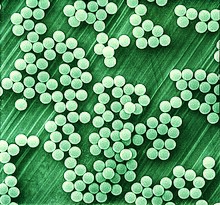Microbead (research)
This article includes a list of references, related reading, or external links, but its sources remain unclear because it lacks inline citations. (May 2014) |
This article needs additional citations for verification. (November 2010) |

Microbeads are uniform polymer particles, typically 0.5 to 500 micrometres in diameter. Bio-reactive molecules can be absorbed or coupled to their surface, and used to separate biological materials such as cells, proteins, or nucleic acids.
Microbeads are used for isolation and handling of specific material or molecules, as well as for analyzing sensitive molecules, or those that are in low abundance, e.g. in miniaturized and automated settings.
Background
Microbeads were created when the late Dr. John Ugelstad managed to form polystyrene beads of the same spherical sizes at the University of Trondheim, Norway in 1976[citation needed]. He then created superparamagnetic microbeads (Dynabeads). These beads exhibit magnetic properties when placed in a magnetic field, with no residual magnetism when removed from the magnetic field, thereby leading to the development of magnetic separation technology.
Microbeads enable fast liquid-phase kinetics, and display a large surface area per volume. Microbeads can execute rapid separation throughout the application protocol by applying a magnet. Other processes such as centrifugation, filtration, columns or precipitation, are not needed.
Uniformity
John Ugelstad was able to develop a method to create uniformly sized microbeads. Polystyrene material was crafted to produce monosized spherical beads. Uniformity of size, shape and surface area provides optimal accessibility and reaction kinetics, for rapid and efficient binding.
Applications
Microbeads serve as the main tool for bio-magnetic separations. A range of patented processes and applications have been developed based on the use of microbeads in academic and industrial research. Microbeads are pre-coupled with a ligand; a biomolecule such as antibody, streptavidin, protein, antigen, DNA/RNA or other molecule. There are three steps involved in the magnetic separation process:
- Bind – Microbeads bind to the desired target, relative to the specific affinity of the ligand on the surface of the beads.
- Wash – Microbeads will move to the side of the tube in response to a magnetic field, along with the bound material. This happens quickly and efficiently because of the magnetic field and the micro-sized particles. The un-bound and un-wanted material that is left behind in the sample is removed by pipetting/aspiration. The bead-bound material is washed using the appropriate buffers, by applying the magnet.
- Elute – Once the bead-bound target is isolated and washed, it can be released in the appropriate solution and desired volume. It can then be used for any downstream application directly, or the microbeads can be released and removed.
Microbeads are used for cell isolation and cell expansion. Proteins and protein complexes can be separated, e.g. in immunoprecipitation protocols. Molecular studies and diagnostics also benefit from microbeads (e.g. immunoassay IVD and nucleic acid IVD). When microbeads are coupled with streptavidin, they offer a very efficient way to isolate any biotinylated molecule. This is frequently used in DNA/RNA binding protein studies, sequencing, and to prepare single stranded templates. Gene expression analysis also benefits from microbeads, such as isolating mRNA for transcriptional analysis.
There are many uses for microbeads, mostly for biotechnology and biomedical research. Microbeads and magnetic separation technology have enabled a range of innovative methods to benefit research on disease prevention, medicine, and other fields to improve the human condition.
See also
References
- Kemshead, JT, Ugelstad, J (1985). "Magnetic separation techniques:their application to medicine", Mol Cell Biochem, 67(1):11-8.
- Vetvicka, V, Fornusek, L (1987). "Polymer microbeads in immunology", Biomaterials, 8(5)341-5.
- Arshady, R (1993). "Microspheres for biomedical applications: preparation of reactive and labelled microspheres", Biomaterials, 14(1):5-15.
- Fonnum, G, Johansson, C, Molteberg, A, Morup, S, Aksnes, E (2005). "Characterization of Dynabeads by magnetization measurements and Mössbauer spectroscopy", Journal of Magnetism and Magnetic Materials, 293:41-47.
